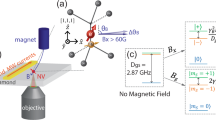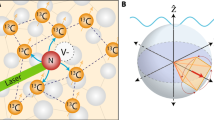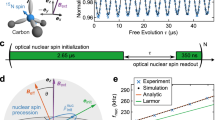Abstract
Magnetic sensors capable of detecting nanoscale volumes of spins allow for non-invasive, element-specific probing1,2,3. The error in such measurements is usually reduced by increasing the measurement time, and noise averaging the signal4,5. However, achieving the best precision requires restricting the maximum possible field strength to much less than the spectral linewidth of the sensor. Quantum entanglement and squeezing can then be used to improve precision (although they are difficult to implement in solid-state environments). When the field strength is comparable to or greater than the spectral linewidth, an undesirable trade-off between field strength and signal precision occurs1. Here, we implement novel phase estimation algorithms6,7,8 on a single electronic spin associated with the nitrogen-vacancy defect centre in diamond to achieve an ∼8.5-fold improvement in the ratio of the maximum field strength to precision, for field magnitudes that are large (∼0.3 mT) compared to the spectral linewidth of the sensor (∼4.5 µT). The field uncertainty in our approach scales as 1/T0.88, compared to 1/T0.5 in the standard measurement approach, where T is the measurement time. Quantum phase estimation algorithms have also recently been implemented using a single nuclear spin in a nitrogen-vacancy centre9. Besides their direct impact on applications in magnetic sensing and imaging at the nanoscale, these results may prove useful in improving a variety of high-precision spectroscopy techniques.
This is a preview of subscription content, access via your institution
Access options
Subscribe to this journal
Receive 12 print issues and online access
$259.00 per year
only $21.58 per issue
Buy this article
- Purchase on Springer Link
- Instant access to full article PDF
Prices may be subject to local taxes which are calculated during checkout




Similar content being viewed by others
Change history
13 January 2012
In the version of this Letter originally published online, in the first paragraph of the Methods section, the definition of um was incorrect. This error has been corrected in all versions of the Letter.
References
Budker, D. & Romalis, M. Optical magnetometry. Nature Phys. 3, 227–234 (2007).
Kleiner, R., Koelle, D., Ludwig, F. & Clarke, J. Superconducting quantum interference devices: state of the art and applications. Proc. IEEE 92, 1534–1548 (2004).
Poggio, M. & Degen, C. L. Force-detected nuclear magnetic resonance: recent advances and future challenges. Nanotechnology 21, 342001 (2010).
Giovannetti, V., Lloyd, S. & Maccone, L. Quantum-enhanced measurements: beating the standard quantum limit. Science 306, 1330–1336 (2004).
Giovannetti, V., Lloyd, S. & Maccone, L. Advances in quantum metrology. Nature Photon. 5, 222–229 (2011).
Higgins, B. L., Berry, D. W., Bartlett, S. D., Wiseman, H. M. & Pryde, G. J. Entanglement-free Heisenberg-limited phase estimation. Nature 450, 393–397 (2007).
Higgins, B. L. et al. Demonstrating Heisenberg-limited unambiguous phase estimation without adaptive measurements. New J. Phys. 11, 073023 (2009).
Said, R. S., Berry, D. W. & Twamley, J. Nanoscale magnetometry using a single-spin system in diamond. Phys. Rev. B 83, 125410 (2011).
Waldherr, G. et al. High dynamic range magnetometry with a single nuclear spin in diamond. Nature Nanotech. http://dx.doi.org/10.1038/nnano.2011.224 (2011).
Taylor, J. M. et al. High-sensitivity diamond magnetometer with nanoscale resolution. Nature Phys. 4, 810–816 (2008).
Maze, J. R. et al. Nanoscale magnetic sensing with an individual electronic spin in diamond. Nature 455, 644–647 (2008).
Balasubramanian, G. et al. Nanoscale imaging magnetometry with diamond spins under ambient conditions. Nature 455, 648–651 (2008).
Bradac, C. et al. Observation and control of blinking nitrogen-vacancy centres in discrete nanodiamonds. Nature Nanotech. 5, 345–349 (2010).
Balasubramanian, G. et al. Ultralong spin coherence time in isotopically engineered diamond. Nature Mater. 8, 383–387 (2009).
Fu, C-C. et al. Characterization and application of single fluorescent nanodiamonds as cellular biomarkers. Proc. Natl Acad. Sci. USA 104, 727–732 (2007).
McGuinness, L. P. et al. Quantum measurement and orientation tracking of fluorescent nanodiamonds inside living cells. Nature Nanotech. 6, 358–363 (2011).
Jelezko, F. et al. Observation of coherent oscillation of a single nuclear spin and realization of a two-qubit conditional quantum gate. Phys. Rev. Lett. 93, 130501 (2004).
Dutt, M. V. G. et al. Quantum register based on individual electronic and nuclear spin qubits in diamond. Science 316, 1312–1316 (2007).
Itano, W. M. et al. Quantum projection noise: population fluctuations in two-level systems. Phys. Rev. A 47, 3554–3570 (1993).
Wineland, D. J., Bollinger, J. J., Itano, W. M., Moore, F. L. & Heinzen, D. J. Spin squeezing and reduced quantum noise in spectroscopy. Phys. Rev. A 46, R6797–R6800 (1992).
Nagata, T., Okamoto, R., O'Brien, J. L., Sasaki, K. & Takeuchi, S. Beating the standard quantum limit with four-entangled photons. Science 316, 726–729 (2007).
Leibfried, D. et al. Toward Heisenberg-limited spectroscopy with multiparticle entangled states. Science 304, 1476–1478 (2004).
Jones, J. A. et al. Magnetic field sensing beyond the standard quantum limit using 10-spin NOON states. Science 324, 1166–1168 (2009).
Childress, L. et al. Coherent dynamics of coupled electron and nuclear spin qubits in diamond. Science 314, 281–285 (2006).
Berry, D. W. et al. How to perform the most accurate possible phase measurements. Phys. Rev. A 80, 052114 (2009).
Giedke, G, Taylor, J. M., D'Alessandro, D., Lukin, M. D. & Imamoglu, A. Quantum measurement of a mesoscopic spin ensemble. Phys. Rev. A 74, 032316 (2006).
Babinec, T. et al. A diamond nanowire single-photon source. Nature Nanotech. 5, 195–199 (2010).
Grinolds, M. S. et al. Quantum control of proximal spins using nanoscale magnetic resonance imaging. Nature Phys. 7, 687–692 (2011).
Jiang, L. et al. Repetitive readout of a single electronic spin via quantum logic with nuclear spin ancillae. Science 326, 267–272 (2009).
De Lange, G., Wang, Z. H., Ristè, D., Dobrovitski, V. V. & Hanson, R. Universal dynamical decoupling of a single solid-state spin from a spin bath. Science 330, 60–63 (2010).
Ryan, C. A., Hodges, J. S. & Cory, D. G. Robust decoupling techniques to extend quantum coherence in diamond. Phys. Rev. Lett. 105, 200402 (2010).
Acknowledgements
The authors would especially like to thank L. Childress for her helpful comments regarding the manuscript. The authors also acknowledge J. Taylor, C. Ryan, J. S. Hodges, G. Waldherr, F. Jelezko and M. D. Lukin for stimulating discussions. This work was supported by an NSF CAREER award (DMR-0847195), NSF PHY-100534, DOE Early Career (DE-SC 0006638) and the Alfred P. Sloan Research Fellowship.
Author information
Authors and Affiliations
Contributions
N.M. and G.D. conceived and designed the experiments, and built the experimental set-up. N.M. and U.M. carried out the measurements. All authors contributed to analysis of the data, discussed the results and commented on the manuscript. G.D. wrote the paper with contributions from all authors.
Corresponding author
Ethics declarations
Competing interests
The authors declare no competing financial interests.
Supplementary information
Supplementary information
Supplementary information (PDF 1366 kb)
Rights and permissions
About this article
Cite this article
Nusran, N., Momeen, M. & Dutt, M. High-dynamic-range magnetometry with a single electronic spin in diamond. Nature Nanotech 7, 109–113 (2012). https://doi.org/10.1038/nnano.2011.225
Received:
Accepted:
Published:
Issue Date:
DOI: https://doi.org/10.1038/nnano.2011.225
This article is cited by
-
High-precision robust monitoring of charge/discharge current over a wide dynamic range for electric vehicle batteries using diamond quantum sensors
Scientific Reports (2022)
-
Quantum-assisted distortion-free audio signal sensing
Nature Communications (2022)
-
Ultra-high dynamic range quantum measurement retaining its sensitivity
Nature Communications (2021)
-
Online adaptive quantum characterization of a nuclear spin
npj Quantum Information (2021)
-
Experimental optical phase measurement approaching the exact Heisenberg limit
Nature Communications (2018)



